Clara® Inhibitor-Tolerant Probe & Probe 1-Step Mixes
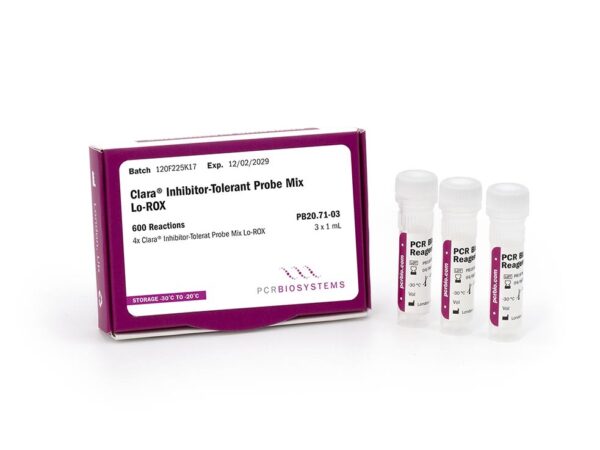
Clara® Inhibitor-Tolerant Probe and Probe 1-Step Mixes are broad-spectrum inhibitor-tolerant 4x mixes for probe-based qPCR and 1-step RT-qPCR.
Get cutting edge DNA and RNA detection even in the presence of PCR inhibitors with Clara® Inhibitor-Tolerant Probe and Probe 1-Step Mixes. These broad spectrum, inhibitor-tolerant qPCR mixes are expertly designed to overcome challenging laboratory, environmental, and clinical sample inhibitors, ensuring reliable results and streamlined workflows for DNA detection. For end-users wishing to amplify RNA we recommend Clara® Inhibitor-Tolerant Probe 1-Step Mix.
Clara® Inhibitor-Tolerant Probe Mixes have been extensively tested against:
- Crude saliva (10%)
- Crude blood (6%)
- Laboratory chemicals (SDS, guanidine, ethanol)
- Clinical inhibitors (hemin, hemoglobin, heparin, lactoferrin, immunoglobulins, urea)
- Plant, and environmental inhibitors (humic acid, catechin, quercetin, tannic acid, cellulose, and chlorophyll).
Features:
- Broad spectrum inhibitor tolerance
- Concentrated 4x mix format, ideal for high-throughput, highly multiplexed assays
- Superior detection of RNA and DNA targets
- Reliable quantification of low template amounts
- Antibody-mediated hot start technology
- Compatible with all real-time PCR platforms – standard and fast cycling conditions
- Standard and ultra-fast cycling (down to 3 min RT reaction and 1 s denaturation, 3 s annealing/extension for PCR)
- 1-Step formulation contains modified UltraScript® RTase and RNase inhibitor in a single-tube format
Applications:
- Species abundance quantification
- Genotyping
- Allelic discrimination
- In vitro diagnostic kit development
- Single & multiplex RNA & DNA detection
- Crude saliva qPCRs
What is the Clara® Inhibitor-Tolerant Probe Mix?
PCR and qPCR can be inhibited by a wide variety of chemical compounds, negatively affecting qPCR workflows and diagnostic processes. Clara® Inhibitor-Tolerant Probe Mix is a 4x reaction-ready mix that includes a DNA polymerase, buffering agents, magnesium, dNTPs, and other necessary components for successful probe-based qPCR, all in a single-tube format. The end user can combine this mix with primers, probes, and templates for single- or multiplex detection. This mix is universally compatible with all probe chemistries, including TaqMan, Scorpions, and molecular beacons, and is maximally compatible with all commercial real-time PCR instruments. Clara® Inhibitor-Tolerant Probe Mix is designed for use in in vitro diagnostic (IVD) kit development and various research applications requiring efficient, reliable qPCR reactions.
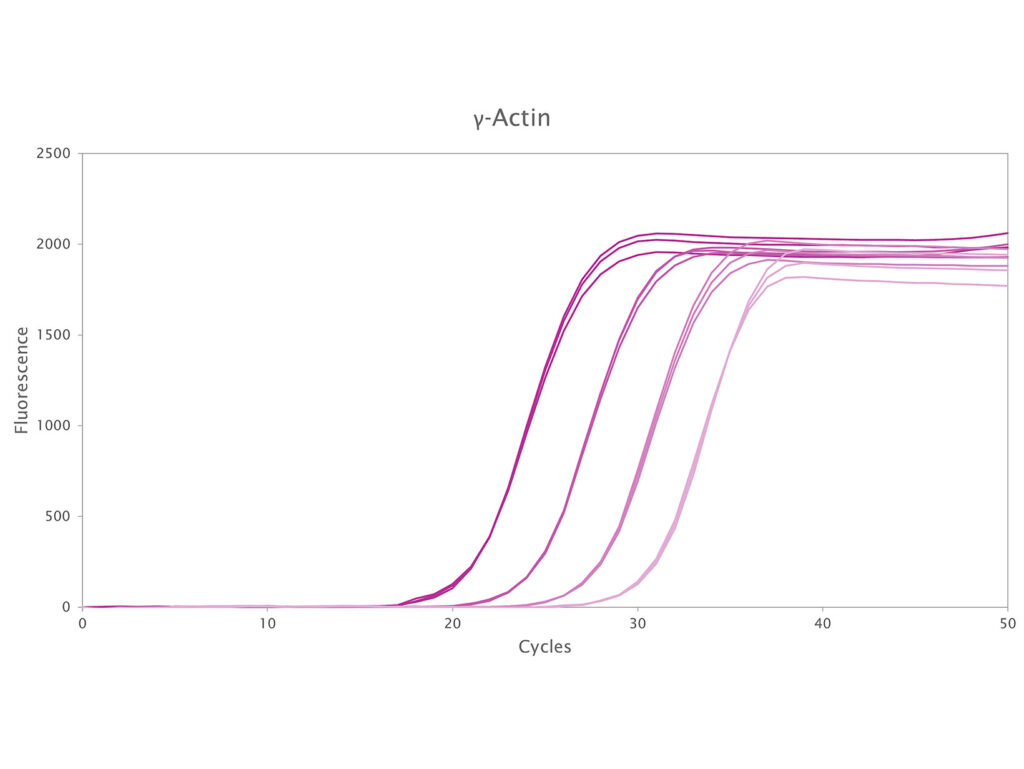
Clara® Inhibitor-Tolerant Probe Mix was used to amplify a serial dilution of γ-actin in a probe-based qPCR reaction. Four template dilutions (250, 25, 25, and 0.25 pg/μL per reaction) with three technical replicates for each target were used in 20 μL reactions. Cycling conditions were: 95 °C for 3 min, followed by 50 cycles of 95 °C for 10 s, and 60 °C for 20 s. Clara® Inhibitor-Tolerant Probe Mix successfully amplifies cDNA targets from as little as 0.25 pg/μL per reaction.
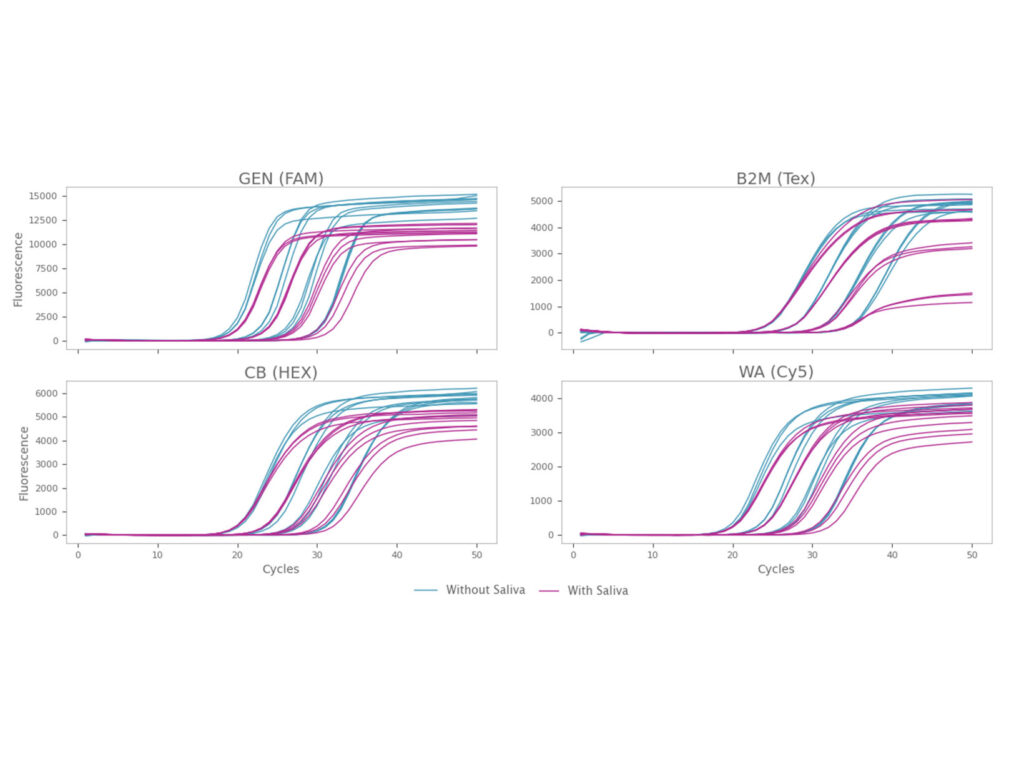
Four DNA targets, GEN (general MPX), β-microtubulin (B2M), CB (Congo Basin MPX), WA (West Africa MPX), were amplified, in the presence (purple) and absence (blue) of human saliva, in a multiplex qPCR assay with Clara® Inhibitor-Tolerant Probe Mix. Four template dilutions (10000, 1000, 100, and 10 copies for the monkeypox (MPX) viral targets, and 250, 25, 2.5, and 0.25 pg/ μL for B2M) with three technical replicates for each target were used in 20 μL reactions. Reactions with saliva contained 5 μL saliva diluted 1/10 in universal transport medium, corresponding to 2.5% human saliva per reaction. Cycling conditions were: 95 °C for 3 min, followed by 50 cycles of 95 °C for 10 s, and 60 °C for 20 s. Clara® Inhibitor-Tolerant Probe Mix successfully amplifies DNA targets in multiplex setup even in the presence of human saliva.
What is the Clara® Inhibitor-Tolerant Probe 1-Step Mix?
Clara® Inhibitor-Tolerant Probe 1-Step Mix is a 4x ready-mix that includes a DNA polymerase, reverse transcriptase (RTase), RNase inhibitor, buffering agents, magnesium, dNTPs, and other necessary components for successful probe-based (RT-)qPCR, all in a single-tube format. The end user can combine this mix with primers, probes, and templates for single- or multiplex detection. This mix is universally compatible with all probe chemistries, including TaqMan, Scorpions, and molecular beacons, and is maximally compatible with all commercial real-time PCR instruments. Clara® Inhibitor-Tolerant Probe 1-Step Mix is designed for use in in vitro diagnostic (IVD) kit development and can also be used in various research applications requiring efficient, reliable (RT-)qPCR reactions.
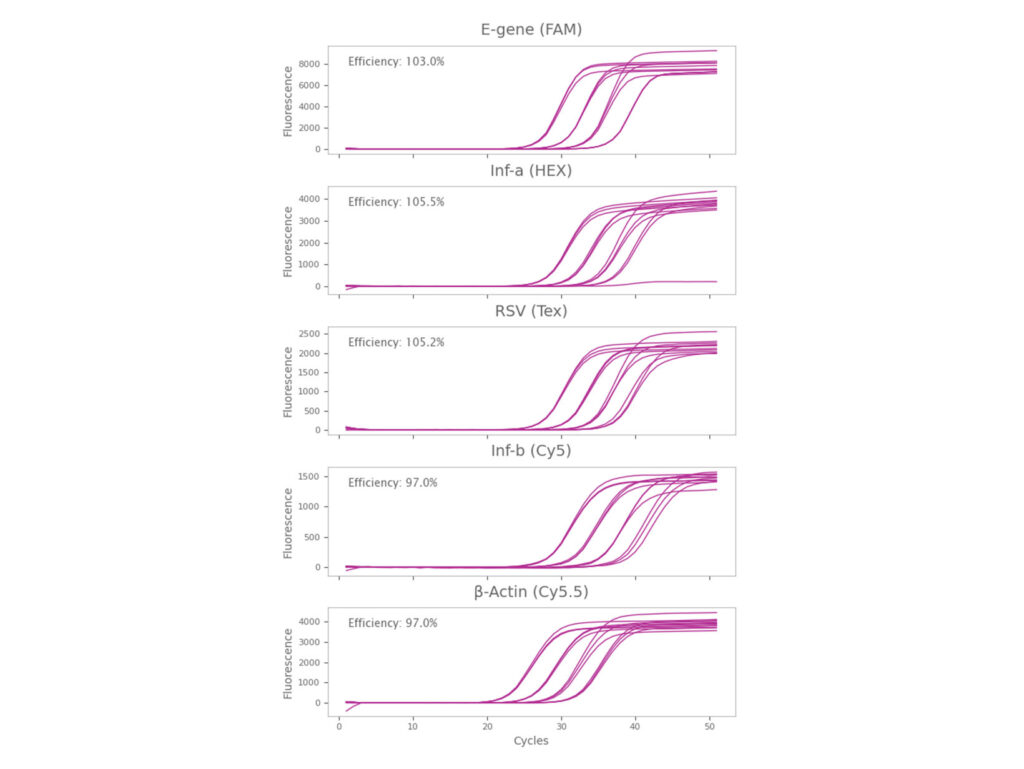
Five RNA targets, SARS-CoV-2 E-gene (E-gene), Influenza-A (INF-A), Influenza-B (INF-B), Respiratory Syncytial Virus (RSV) and mouse β-actin were amplified in multiplex 1-step RT-qPCR reactions with Clara® Inhibitor-Tolerant Probe 1-Step Mix. Four template dilutions (4000, 400, 40, and 4 copies, for viral targets, and 1.25 ng/μL, 125 pg/μL, 12.5 pg/μL, and 1.25 pg/μL total mouse RNA for β-Actin) with three technical replicates per dilution were used in 20 μL reactions. Cycling conditions were: 47 °C for 10 min, 95 °C for 2 min, followed by 50 cycles of 95 °C for 10 s, and 60 °C for 30 s. Clara® Inhibitor-Tolerant Probe 1-Step Mix shows high sensitivity and efficiency under standard cycling conditions in a pentaplex 1-step RT-qPCR reaction setup.
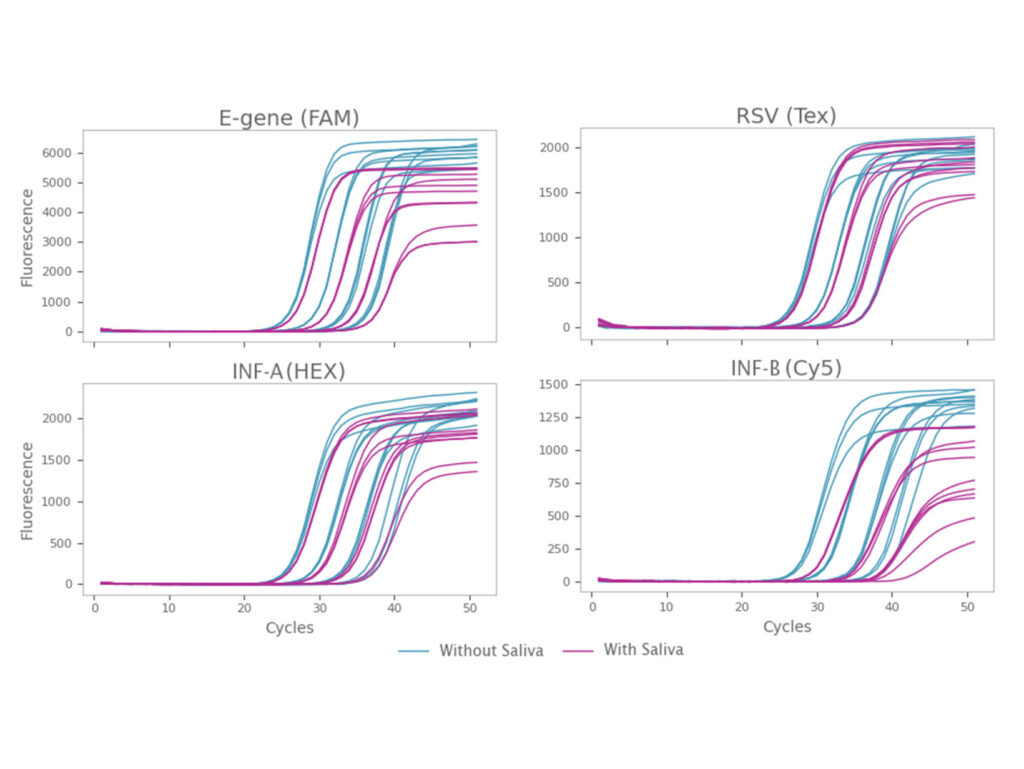
Four RNA targets, SARS-CoV-2 E-gene (E-gene), Respiratory Syncytial Virus (RSV), Influenza-a (INF-A), and Influenza-b (INF-B), were amplified, in the presence (purple) and absence (blue) of human saliva, in multiplex 1-step RT-qPCR reactions with Clara® Inhibitor-Tolerant Probe 1-Step Mix. Four template dilutions (4000, 400, 40, and 4 copies) with three technical replicates for each target were used in 20 μL reactions. Reactions with saliva contained 5 μL saliva diluted 1/10 in universal transport medium, corresponding to 2.5% human saliva per reaction. Cycling conditions were: 47 °C for 10 min, 95 °C for 2 min, followed by 50 cycles of 95 °C for 10 s, and 60 °C for 30 s. Clara® Inhibitor-Tolerant Probe 1-Step Mix successfully amplifies RNA targets in multiplex setup even in the presence of human saliva.
What type of templates are the Clara® Inhibitor-Tolerant Probe Mixes suitable for?
The Clara® Inhibitor-Tolerant Probe Mix is suitable for the amplification of DNA templates. Clara® Inhibitor-Tolerant Probe 1-Step Mix is suitable for both RNA and DNA template amplification with no loss in efficiency when amplifying mixed templates.
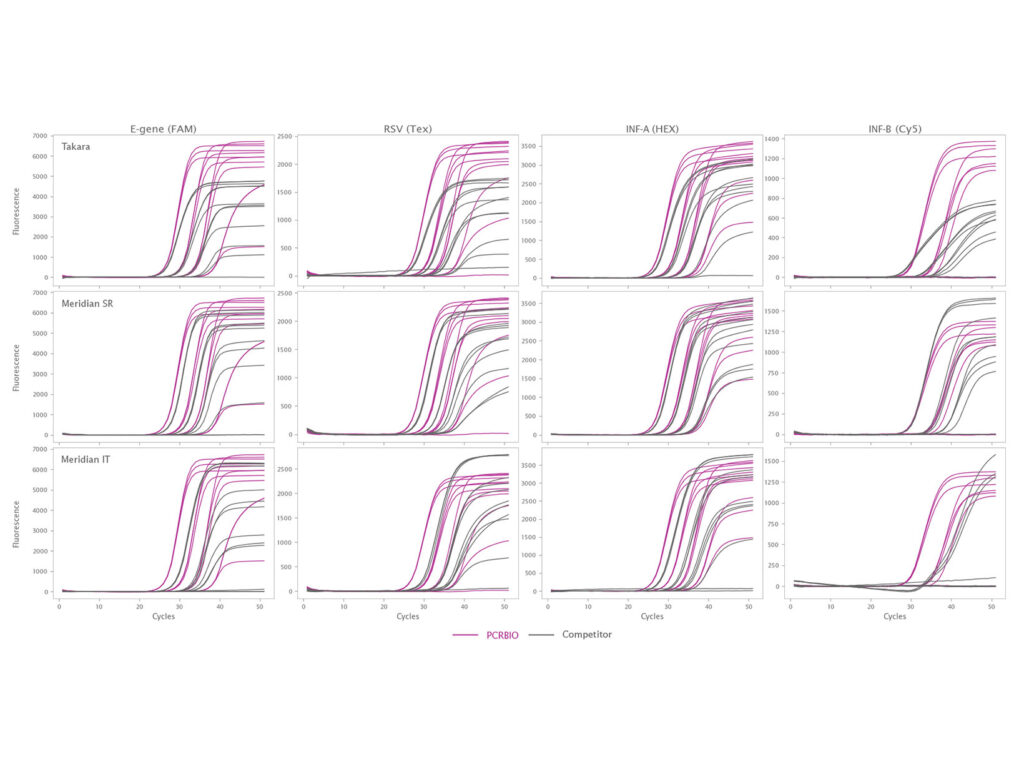
Four RNA targets, SARS-CoV-2 E-gene (E-gene), Respiratory Syncytial Virus (RSV), Influenza-A (INF-A), and Influenza-B (INF-B) were amplified, in the presence of human saliva, in multiplex 1-step RT-qPCR reactions with: Clara® Inhibitor-Tolerant Probe 1-Step Mix (purple, PCRBIO), One Step PrimeScript III RT-PCR Kit from Takara (grey, Takara), Air-Dryable Direct RNA/DNA qPCR Saliva (grey, Meridian SR), and Inhibitor-Tolerant RT-qPCR Mix (grey, Meridian IT) from Meridian. Four template dilutions (4000, 400, 40, and 4 copies) with three technical replicates for each target were used in 20 μL reactions. Reactions with saliva contained 5 μL saliva diluted 1/10 in universal transport medium, corresponding to 2.5% human saliva per reaction. Cycling conditions were: 47 °C for 10 min, 95 °C for 2 min, followed by 50 cycles of 95 °C for 10 s, and 60 °C for 30 s. Clara® Inhibitor-Tolerant Probe 1-Step Mix matches or outperforms three competitor products in multiplex setup in the presence of human saliva.
Types of inhibitors Clara® Inhibitor-Tolerant Probe Mixes tolerate.
The Clara® Inhibitor-Tolerant Probe and Probe 1-Step Mix have been tested against, and are tolerant to, a broad range of common PCR inhibitors, including standard laboratory chemicals (SDS, guanidine, and ethanol) and biological sample inhibitors, such as those found in blood samples (hemin, hematin, haemoglobin, heparin, IgG immunoglobulins, lactoferrin, sodium citrate), saliva, urine (urea), plant, and environmental samples (humic acid, catechin, quercetin, tannic acid, cellulose, and chlorophyll). The mix has been extensively validated against crude (or diluted) saliva and blood, along with multiple other pure chemical inhibitors.
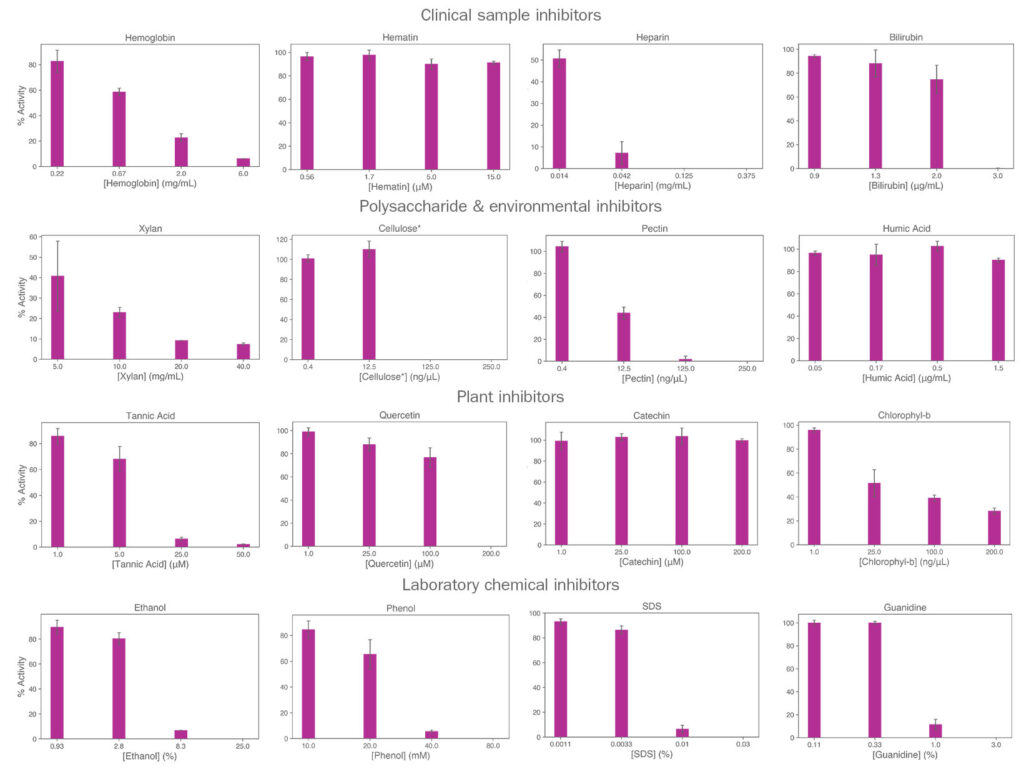
Related Links
Documents
Product Flyers
Product Manuals
- PB20.71 Clara® Inhibitor-Tolerant Probe Mix Lo-ROX Manual
- PB20.72 Clara® Inhibitor-Tolerant Probe Mix Hi-ROX Manual
- PB20.73 Clara® Inhibitor-Tolerant Probe Mix No-ROX Manual
- PB20.74 Clara® Inhibitor-Tolerant Probe Mix Separate-ROX Manual
- PB25.91 Clara® Inhibitor-Tolerant Probe 1-Step Mix Lo-ROX Manual
- PB25.92 Clara® Inhibitor-Tolerant Probe 1-Step Mix Hi-ROX Manual
- PB25.93 Clara® Inhibitor-Tolerant Probe 1-Step Mix No-ROX Manual
- PB25.94 Clara® Inhibitor-Tolerant Probe 1-Step Mix Separate-ROX Manual
Material Safety Data Sheets
- PB20.71 Clara® Inhibitor-Tolerant Probe Mix Lo-ROX MSDS
- PB20.72 Clara® Inhibitor-Tolerant Probe Mix Hi-ROX MSDS
- PB20.73 Clara® Inhibitor-Tolerant Probe Mix No-ROX MSDS
- PB20.74 Clara® Inhibitor-Tolerant Probe Mix Separate-ROX MSDS
- PB25.91 Clara® Inhibitor-Tolerant Probe 1-Step Mix Lo-ROX MSDS
- PB25.92 Clara® Inhibitor-Tolerant Probe 1-Step Mix Hi-ROX MSDS
- PB25.93 Clara® Inhibitor-Tolerant Probe 1-Step Mix No-ROX MSDS
- PB25.94 Clara® Inhibitor-Tolerant Probe 1-Step Mix Separate-ROX MSDS
Application Notes
Certificate of Analysis Finder
Specifications
Clara® Inhibitor-Tolerant Probe (1-Step) Mix Lo-ROX
Component
200 Reactions
600 Reactions
1000 Reactions
10,000 Reactions
4x Clara Inhibitor-Tolerant Probe (1-Step) Mix Lo-ROX
1 x 1 mL
3 x 1 mL
5 x 1 mL
1 x 50 mL
Clara® Inhibitor-Tolerant Probe (1-Step) Mix Hi-ROX
Component
200 Reactions
600 Reactions
1000 Reactions
10,000 Reactions
4x Clara Inhibitor-Tolerant Probe Mix (1-Step) Hi-ROX
1 x 1 mL
3 x 1 mL
5 x 1 mL
1 x 50 mL
Clara® Inhibitor-Tolerant Probe (1-Step) Mix No-ROX
Component
200 Reactions
600 Reactions
1000 Reactions
10,000 Reactions
4x Clara Inhibitor-Tolerant Probe (1-Step) Mix No-ROX
1 x 1 mL
3 x 1 mL
5 x 1 mL
1 x 50 mL
Clara® Inhibitor-Tolerant Probe (1-Step) Mix Separate-ROX
Component
200 Reactions
600 Reactions
1000 Reactions
4x Clara Inhibitor-Tolerant Probe (1-Step) Mix No-ROX
1 x 1 mL
3 x 1 mL
5 x 1 mL
50 μΜ ROX Additive
1 x 200 μL
1 x 200 μL
1 x 200 μL
Clara® Inhibitor-Tolerant Probe (1-Step) Mix Lo-ROX
Component
4x Clara Inhibitor-Tolerant Probe (1-Step) Mix Lo-ROX
200 Reactions
1 x 1 mL
600 Reactions
3 x 1 mL
1000 Reactions
5 x 1 mL
10,000 Reactions
1 x 50 mL
Clara® Inhibitor-Tolerant Probe (1-Step) Mix Hi-ROX
Component
4x Clara Inhibitor-Tolerant Probe Mix (1-Step) Hi-ROX
200 Reactions
1 x 1 mL
600 Reactions
3 x 1 mL
1000 Reactions
5 x 1 mL
10,000 Reactions
1 x 50 mL
Clara® Inhibitor-Tolerant Probe (1-Step) Mix No-ROX
Component
4x Clara Inhibitor-Tolerant Probe (1-Step) Mix No-ROX
200 Reactions
1 x 1 mL
600 Reactions
3 x 1 mL
1000 Reactions
5 x 1 mL
10,000 Reactions
1 x 50 mL
Clara® Inhibitor-Tolerant Probe (1-Step) Mix Separate-ROX
Component
4x Clara Inhibitor-Tolerant Probe (1-Step) Mix No-ROX
50 μΜ ROX Additive
200 Reactions
1 x 1 mL
1 x 200 μL
600 Reactions
3 x 1 mL
1 x 200 μL
1000 Reactions
5 x 1 mL
1 x 200 μL
Reaction Volume
Storage
20 μL
On arrival, products should be stored between -30 °C and -20 °C. If stored correctly the kit will retain full activity until the indicated expiry date.
Reaction Volume
20 μL
Storage
On arrival, products should be stored between -30 °C and -20 °C. If stored correctly the kit will retain full activity until the indicated expiry date.
Instrument Compatibility
This product is compatible with all standard and fast cycling qPCR instruments. Use our qPCR Selection Tool to find out which ROX variant is compatible with your instrument.
FAQs
Can I conduct fast cycling with this mix?
Reliable amplification for various targets has been achieved using 40 cycles with 1 s denaturation and 3 s annealing and extension (2-step cycling). Successful amplification under these conditions requires reasonably short amplicons and should be tested on case-by-case basis for all new targets added to an experiment.
Can I use crude plant extracts with this mix?
Results will differ depending on the plant species and tissue type. Our inhibitor-tolerant chemistry shows moderate resistance to chlorophyll and polyphenols, such as catechin and quercetin, but low resistance to tannic acid, cellulose and pectin. Thus, testing the mix on the desired sample types is recommend. All plant tissues will require mechanical lysis in an appropriate extraction buffer to achieve disruption of cell walls and membranes, prior to use with inhibitor-tolerant mixes. We recommend testing a small number of reactions on the target sample type. Please reach out to our team [email protected] to request a product sample, or if you need assistance in planning such test reactions.
Is it normal to see different levels of inhibition with different crude samples?
Yes, this is expected. Crude biological samples, particularly saliva, contain different levels of PCR inhibitors. We have observed a range of 0.5-3.5 cycles delay in amplification of the same target with different saliva samples. The same crude biological sample may also show different levels of inhibition over time.
Is it normal to see some delay in Cq in the presence of crude samples?
Yes. While the mix is inhibitor-tolerant, it is not completely resistant to the presence of inhibitors. Different inhibitors and higher concentrations can still inhibit qPCR reactions. Given the sensitivity of the mix, if a significant delay is observed, we recommend diluting the sample before using in qPCR reactions.
Do I need to pre-treat saliva samples before using them with this mix?
Saliva samples do not require pre-treatment. However, dilution in appropriate sample transport medium is recommended. We highly recommend the use of UTM which don’t contain guanidinum chloride.
How much crude saliva can I add per reaction?
We have successfully tested up to 10% crude saliva per reaction, with best, most-consistent results when using 2.5% saliva
How much crude blood can I add per reaction?
We have successfully carried out multiplex reactions on up to 5 μL of blood sample (1.25 μL of crude blood diluted 1:4 in a NaCl/EDTA solution) per 20 μL reaction. This does lead to a reduction in overall fluorescence but does not inhibit qPCR reactions themselves, nor does it limit the sensitivity of the mix.
What inhibitors does this mix tolerate?
All our inhibitor-tolerant mixes have been tested on and tolerate crude saliva and crude blood. Additionally, they have been extensively tested in the presence of multiple PCR inhibitors found in clinical, plant, environmental, and laboratory chemicals . These include: hemin, haemoglobin, heparin, lactoferrin, IgG immunoglobulins, guanidine, SDS, ethanol, urea, sodium citrate, humic acid, cellulose, pectin, quercetin, catechin, tannic acid, and chlorophyll B. The extent of tolerance varies by compound. The mixes may also be tolerant to other compounds, not listed, or not yet tested.
Clara® Inhibitor-Tolerant Probe Mixes have been extensively tested against:
- Crude saliva (10%)
- Crude blood (6%)
- Laboratory chemicals (SDS, guanidine, ethanol)
- Clinical inhibitors (hemin, hemoglobin, heparin, lactoferrin, immunoglobulins, urea)
- Plant, and environmental inhibitors (humic acid, catechin, quercetin, tannic acid, cellulose, and chlorophyll).
Features:
- Broad spectrum inhibitor tolerance
- Concentrated 4x mix format, ideal for high-throughput, highly multiplexed assays
- Superior detection of RNA and DNA targets
- Reliable quantification of low template amounts
- Antibody-mediated hot start technology
- Compatible with all real-time PCR platforms – standard and fast cycling conditions
- Standard and ultra-fast cycling (down to 3 min RT reaction and 1 s denaturation, 3 s annealing/extension for PCR)
- 1-Step formulation contains modified UltraScript® RTase and RNase inhibitor in a single-tube format
Applications:
- Species abundance quantification
- Genotyping
- Allelic discrimination
- In vitro diagnostic kit development
- Single & multiplex RNA & DNA detection
- Crude saliva qPCRs
What is the Clara® Inhibitor-Tolerant Probe Mix?
PCR and qPCR can be inhibited by a wide variety of chemical compounds, negatively affecting qPCR workflows and diagnostic processes. Clara® Inhibitor-Tolerant Probe Mix is a 4x reaction-ready mix that includes a DNA polymerase, buffering agents, magnesium, dNTPs, and other necessary components for successful probe-based qPCR, all in a single-tube format. The end user can combine this mix with primers, probes, and templates for single- or multiplex detection. This mix is universally compatible with all probe chemistries, including TaqMan, Scorpions, and molecular beacons, and is maximally compatible with all commercial real-time PCR instruments. Clara® Inhibitor-Tolerant Probe Mix is designed for use in in vitro diagnostic (IVD) kit development and various research applications requiring efficient, reliable qPCR reactions.

Clara® Inhibitor-Tolerant Probe Mix was used to amplify a serial dilution of γ-actin in a probe-based qPCR reaction. Four template dilutions (250, 25, 25, and 0.25 pg/μL per reaction) with three technical replicates for each target were used in 20 μL reactions. Cycling conditions were: 95 °C for 3 min, followed by 50 cycles of 95 °C for 10 s, and 60 °C for 20 s. Clara® Inhibitor-Tolerant Probe Mix successfully amplifies cDNA targets from as little as 0.25 pg/μL per reaction.

Four DNA targets, GEN (general MPX), β-microtubulin (B2M), CB (Congo Basin MPX), WA (West Africa MPX), were amplified, in the presence (purple) and absence (blue) of human saliva, in a multiplex qPCR assay with Clara® Inhibitor-Tolerant Probe Mix. Four template dilutions (10000, 1000, 100, and 10 copies for the monkeypox (MPX) viral targets, and 250, 25, 2.5, and 0.25 pg/ μL for B2M) with three technical replicates for each target were used in 20 μL reactions. Reactions with saliva contained 5 μL saliva diluted 1/10 in universal transport medium, corresponding to 2.5% human saliva per reaction. Cycling conditions were: 95 °C for 3 min, followed by 50 cycles of 95 °C for 10 s, and 60 °C for 20 s. Clara® Inhibitor-Tolerant Probe Mix successfully amplifies DNA targets in multiplex setup even in the presence of human saliva.
What is the Clara® Inhibitor-Tolerant Probe 1-Step Mix?
Clara® Inhibitor-Tolerant Probe 1-Step Mix is a 4x ready-mix that includes a DNA polymerase, reverse transcriptase (RTase), RNase inhibitor, buffering agents, magnesium, dNTPs, and other necessary components for successful probe-based (RT-)qPCR, all in a single-tube format. The end user can combine this mix with primers, probes, and templates for single- or multiplex detection. This mix is universally compatible with all probe chemistries, including TaqMan, Scorpions, and molecular beacons, and is maximally compatible with all commercial real-time PCR instruments. Clara® Inhibitor-Tolerant Probe 1-Step Mix is designed for use in in vitro diagnostic (IVD) kit development and can also be used in various research applications requiring efficient, reliable (RT-)qPCR reactions.

Five RNA targets, SARS-CoV-2 E-gene (E-gene), Influenza-A (INF-A), Influenza-B (INF-B), Respiratory Syncytial Virus (RSV) and mouse β-actin were amplified in multiplex 1-step RT-qPCR reactions with Clara® Inhibitor-Tolerant Probe 1-Step Mix. Four template dilutions (4000, 400, 40, and 4 copies, for viral targets, and 1.25 ng/μL, 125 pg/μL, 12.5 pg/μL, and 1.25 pg/μL total mouse RNA for β-Actin) with three technical replicates per dilution were used in 20 μL reactions. Cycling conditions were: 47 °C for 10 min, 95 °C for 2 min, followed by 50 cycles of 95 °C for 10 s, and 60 °C for 30 s. Clara® Inhibitor-Tolerant Probe 1-Step Mix shows high sensitivity and efficiency under standard cycling conditions in a pentaplex 1-step RT-qPCR reaction setup.

Four RNA targets, SARS-CoV-2 E-gene (E-gene), Respiratory Syncytial Virus (RSV), Influenza-a (INF-A), and Influenza-b (INF-B), were amplified, in the presence (purple) and absence (blue) of human saliva, in multiplex 1-step RT-qPCR reactions with Clara® Inhibitor-Tolerant Probe 1-Step Mix. Four template dilutions (4000, 400, 40, and 4 copies) with three technical replicates for each target were used in 20 μL reactions. Reactions with saliva contained 5 μL saliva diluted 1/10 in universal transport medium, corresponding to 2.5% human saliva per reaction. Cycling conditions were: 47 °C for 10 min, 95 °C for 2 min, followed by 50 cycles of 95 °C for 10 s, and 60 °C for 30 s. Clara® Inhibitor-Tolerant Probe 1-Step Mix successfully amplifies RNA targets in multiplex setup even in the presence of human saliva.
What type of templates are the Clara® Inhibitor-Tolerant Probe Mixes suitable for?
The Clara® Inhibitor-Tolerant Probe Mix is suitable for the amplification of DNA templates. Clara® Inhibitor-Tolerant Probe 1-Step Mix is suitable for both RNA and DNA template amplification with no loss in efficiency when amplifying mixed templates.

Four RNA targets, SARS-CoV-2 E-gene (E-gene), Respiratory Syncytial Virus (RSV), Influenza-A (INF-A), and Influenza-B (INF-B) were amplified, in the presence of human saliva, in multiplex 1-step RT-qPCR reactions with: Clara® Inhibitor-Tolerant Probe 1-Step Mix (purple, PCRBIO), One Step PrimeScript III RT-PCR Kit from Takara (grey, Takara), Air-Dryable Direct RNA/DNA qPCR Saliva (grey, Meridian SR), and Inhibitor-Tolerant RT-qPCR Mix (grey, Meridian IT) from Meridian. Four template dilutions (4000, 400, 40, and 4 copies) with three technical replicates for each target were used in 20 μL reactions. Reactions with saliva contained 5 μL saliva diluted 1/10 in universal transport medium, corresponding to 2.5% human saliva per reaction. Cycling conditions were: 47 °C for 10 min, 95 °C for 2 min, followed by 50 cycles of 95 °C for 10 s, and 60 °C for 30 s. Clara® Inhibitor-Tolerant Probe 1-Step Mix matches or outperforms three competitor products in multiplex setup in the presence of human saliva.
Types of inhibitors Clara® Inhibitor-Tolerant Probe Mixes tolerate.
The Clara® Inhibitor-Tolerant Probe and Probe 1-Step Mix have been tested against, and are tolerant to, a broad range of common PCR inhibitors, including standard laboratory chemicals (SDS, guanidine, and ethanol) and biological sample inhibitors, such as those found in blood samples (hemin, hematin, haemoglobin, heparin, IgG immunoglobulins, lactoferrin, sodium citrate), saliva, urine (urea), plant, and environmental samples (humic acid, catechin, quercetin, tannic acid, cellulose, and chlorophyll). The mix has been extensively validated against crude (or diluted) saliva and blood, along with multiple other pure chemical inhibitors.

Related Links
Request a Quote & Sample
Your Selection:
Documents
Product Flyers
Product Manuals
- PB20.71 Clara® Inhibitor-Tolerant Probe Mix Lo-ROX Manual
- PB20.72 Clara® Inhibitor-Tolerant Probe Mix Hi-ROX Manual
- PB20.73 Clara® Inhibitor-Tolerant Probe Mix No-ROX Manual
- PB20.74 Clara® Inhibitor-Tolerant Probe Mix Separate-ROX Manual
- PB25.91 Clara® Inhibitor-Tolerant Probe 1-Step Mix Lo-ROX Manual
- PB25.92 Clara® Inhibitor-Tolerant Probe 1-Step Mix Hi-ROX Manual
- PB25.93 Clara® Inhibitor-Tolerant Probe 1-Step Mix No-ROX Manual
- PB25.94 Clara® Inhibitor-Tolerant Probe 1-Step Mix Separate-ROX Manual
Material Safety Data Sheets
- PB20.71 Clara® Inhibitor-Tolerant Probe Mix Lo-ROX MSDS
- PB20.72 Clara® Inhibitor-Tolerant Probe Mix Hi-ROX MSDS
- PB20.73 Clara® Inhibitor-Tolerant Probe Mix No-ROX MSDS
- PB20.74 Clara® Inhibitor-Tolerant Probe Mix Separate-ROX MSDS
- PB25.91 Clara® Inhibitor-Tolerant Probe 1-Step Mix Lo-ROX MSDS
- PB25.92 Clara® Inhibitor-Tolerant Probe 1-Step Mix Hi-ROX MSDS
- PB25.93 Clara® Inhibitor-Tolerant Probe 1-Step Mix No-ROX MSDS
- PB25.94 Clara® Inhibitor-Tolerant Probe 1-Step Mix Separate-ROX MSDS
Application Notes
Certificate of Analysis Finder
Specifications
Clara® Inhibitor-Tolerant Probe (1-Step) Mix Lo-ROX
Component
200 Reactions
600 Reactions
1000 Reactions
10,000 Reactions
4x Clara Inhibitor-Tolerant Probe (1-Step) Mix Lo-ROX
1 x 1 mL
3 x 1 mL
5 x 1 mL
1 x 50 mL
Clara® Inhibitor-Tolerant Probe (1-Step) Mix Hi-ROX
Component
200 Reactions
600 Reactions
1000 Reactions
10,000 Reactions
4x Clara Inhibitor-Tolerant Probe Mix (1-Step) Hi-ROX
1 x 1 mL
3 x 1 mL
5 x 1 mL
1 x 50 mL
Clara® Inhibitor-Tolerant Probe (1-Step) Mix No-ROX
Component
200 Reactions
600 Reactions
1000 Reactions
10,000 Reactions
4x Clara Inhibitor-Tolerant Probe (1-Step) Mix No-ROX
1 x 1 mL
3 x 1 mL
5 x 1 mL
1 x 50 mL
Clara® Inhibitor-Tolerant Probe (1-Step) Mix Separate-ROX
Component
200 Reactions
600 Reactions
1000 Reactions
4x Clara Inhibitor-Tolerant Probe (1-Step) Mix No-ROX
1 x 1 mL
3 x 1 mL
5 x 1 mL
50 μΜ ROX Additive
1 x 200 μL
1 x 200 μL
1 x 200 μL
Clara® Inhibitor-Tolerant Probe (1-Step) Mix Lo-ROX
Component
4x Clara Inhibitor-Tolerant Probe (1-Step) Mix Lo-ROX
200 Reactions
1 x 1 mL
600 Reactions
3 x 1 mL
1000 Reactions
5 x 1 mL
10,000 Reactions
1 x 50 mL
Clara® Inhibitor-Tolerant Probe (1-Step) Mix Hi-ROX
Component
4x Clara Inhibitor-Tolerant Probe Mix (1-Step) Hi-ROX
200 Reactions
1 x 1 mL
600 Reactions
3 x 1 mL
1000 Reactions
5 x 1 mL
10,000 Reactions
1 x 50 mL
Clara® Inhibitor-Tolerant Probe (1-Step) Mix No-ROX
Component
4x Clara Inhibitor-Tolerant Probe (1-Step) Mix No-ROX
200 Reactions
1 x 1 mL
600 Reactions
3 x 1 mL
1000 Reactions
5 x 1 mL
10,000 Reactions
1 x 50 mL
Clara® Inhibitor-Tolerant Probe (1-Step) Mix Separate-ROX
Component
4x Clara Inhibitor-Tolerant Probe (1-Step) Mix No-ROX
50 μΜ ROX Additive
200 Reactions
1 x 1 mL
1 x 200 μL
600 Reactions
3 x 1 mL
1 x 200 μL
1000 Reactions
5 x 1 mL
1 x 200 μL
Reaction Volume
Storage
20 μL
On arrival, products should be stored between -30 °C and -20 °C. If stored correctly the kit will retain full activity until the indicated expiry date.
Reaction Volume
20 μL
Storage
On arrival, products should be stored between -30 °C and -20 °C. If stored correctly the kit will retain full activity until the indicated expiry date.
Instrument Compatibility
This product is compatible with all standard and fast cycling qPCR instruments. Use our qPCR Selection Tool to find out which ROX variant is compatible with your instrument.
FAQs
Can I conduct fast cycling with this mix?
Reliable amplification for various targets has been achieved using 40 cycles with 1 s denaturation and 3 s annealing and extension (2-step cycling). Successful amplification under these conditions requires reasonably short amplicons and should be tested on case-by-case basis for all new targets added to an experiment.
Can I use crude plant extracts with this mix?
Results will differ depending on the plant species and tissue type. Our inhibitor-tolerant chemistry shows moderate resistance to chlorophyll and polyphenols, such as catechin and quercetin, but low resistance to tannic acid, cellulose and pectin. Thus, testing the mix on the desired sample types is recommend. All plant tissues will require mechanical lysis in an appropriate extraction buffer to achieve disruption of cell walls and membranes, prior to use with inhibitor-tolerant mixes. We recommend testing a small number of reactions on the target sample type. Please reach out to our team [email protected] to request a product sample, or if you need assistance in planning such test reactions.
Is it normal to see different levels of inhibition with different crude samples?
Yes, this is expected. Crude biological samples, particularly saliva, contain different levels of PCR inhibitors. We have observed a range of 0.5-3.5 cycles delay in amplification of the same target with different saliva samples. The same crude biological sample may also show different levels of inhibition over time.
Is it normal to see some delay in Cq in the presence of crude samples?
Yes. While the mix is inhibitor-tolerant, it is not completely resistant to the presence of inhibitors. Different inhibitors and higher concentrations can still inhibit qPCR reactions. Given the sensitivity of the mix, if a significant delay is observed, we recommend diluting the sample before using in qPCR reactions.
Do I need to pre-treat saliva samples before using them with this mix?
Saliva samples do not require pre-treatment. However, dilution in appropriate sample transport medium is recommended. We highly recommend the use of UTM which don’t contain guanidinum chloride.
How much crude saliva can I add per reaction?
We have successfully tested up to 10% crude saliva per reaction, with best, most-consistent results when using 2.5% saliva
How much crude blood can I add per reaction?
We have successfully carried out multiplex reactions on up to 5 μL of blood sample (1.25 μL of crude blood diluted 1:4 in a NaCl/EDTA solution) per 20 μL reaction. This does lead to a reduction in overall fluorescence but does not inhibit qPCR reactions themselves, nor does it limit the sensitivity of the mix.
What inhibitors does this mix tolerate?
All our inhibitor-tolerant mixes have been tested on and tolerate crude saliva and crude blood. Additionally, they have been extensively tested in the presence of multiple PCR inhibitors found in clinical, plant, environmental, and laboratory chemicals . These include: hemin, haemoglobin, heparin, lactoferrin, IgG immunoglobulins, guanidine, SDS, ethanol, urea, sodium citrate, humic acid, cellulose, pectin, quercetin, catechin, tannic acid, and chlorophyll B. The extent of tolerance varies by compound. The mixes may also be tolerant to other compounds, not listed, or not yet tested.




